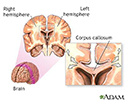Aicardi syndrome
Agenesis of corpus callosum with chorioretinal abnormality; Agenesis of corpus callosum with infantile spasms and ocular abnormalities; Callosal agenesis and ocular abnormalities; Chorioretinal anomalies with ACC
Aicardi syndrome is a rare disorder. In this condition, the structure that connects the two sides of the brain (called the corpus callosum) is partly or completely missing. Nearly all known cases occur in people with no history of the disorder in their family (sporadic).
Causes
The cause of Aicardi syndrome is unknown at this time. In some cases, experts believe it may be a result of a gene defect on the X chromosome.
The disorder affects only girls.
Symptoms
Symptoms most often start when the child is between ages 3 and 5 months. The condition causes jerking (infantile spasms), a type of childhood seizure.
Aicardi syndrome may occur with other brain defects.
Other symptoms may include:
- Coloboma (an area of missing tissue in the eye)
- Intellectual disability
- Smaller-than-normal eyes (microphthalmia)
Exams and Tests
Children are diagnosed with Aicardi syndrome if they meet the following criteria:
- Corpus callosum that is partly or completely missing
- Female sex
- Seizures (typically beginning as infantile spasms)
- Sores on the retina (retinal lesions) or optic nerve
In rare cases, one of these features may be missing (especially lack of development of the corpus callosum).
Tests to diagnose Aicardi syndrome include:
- CT scan of the head
- Electroencephalogram (EEG)
- Eye exam
- MRI of the head
Other procedures and tests may be done, depending on the person.
Treatment
Treatment is done to help prevent symptoms. It involves managing seizures and any other health concerns. Treatment uses programs to help the family and child cope with delays in development.
Support Groups
Aicardi Syndrome Foundation -- aicardisyndromefoundation.org/
National Organization for Rare Disorders (NORD) -- rarediseases.org
Outlook (Prognosis)
The outlook depends on how severe the symptoms are and what other health conditions are present.
Nearly all children with this syndrome have severe learning difficulties and remain completely dependent on others. However, a few have some language abilities and some can walk on their own or with support. Vision varies from normal to blind.
Possible Complications
Complications depend on the severity of symptoms.
When to Contact a Medical Professional
Contact your health care provider if your child has symptoms of Aicardi syndrome. Seek emergency care if the infant is having spasms or a seizure.
References
American Academy of Ophthalmology website. Aicardi syndrome. www.aao.org/education/pediatric-center-detail/neuro-ophthalmology-aicardi-syndrome. Updated September 2, 2020. Accessed August 1, 2024.
Samat HB, Flores-Samat L. Developmental disorders of the nervous system. In: Jankovic J, Mazziotta JC, Pomeroy SL, Newman NJ, eds. Bradley and Daroff's Neurology in Clinical Practice. 8th ed. Philadelphia, PA: Elsevier; 2022:chap 89.
Trowbridge SK, Yang E, Yuskaitis CJ. Congenital anomalies of the central nervous system. In: Kliegman RM, St. Geme JW, Blum NJ, et al, eds. Nelson Textbook of Pediatrics. 22nd ed. Philadelphia, PA: Elsevier; 2025:chap 631.
Review Date: 7/16/2024








